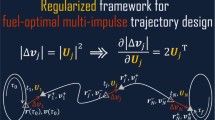Abstract
Frozen orbits and Sun-synchronous orbits are useful in exploration of terrestrial planets’ surface and atmosphere with a view to future human exploration. This work therefore develops novel orbits around terrestrial planets using continuous low-thrust propulsion to enable one new and unique investigations of the planets. This paper considers the use of continuous acceleration by solar electric propulsion, to achieve artificial frozen orbits and artificial Sun-synchronous orbits around terrestrial planets. These artificial orbits are similar to natural frozen orbits and Sun-synchronous orbits around Mercury, Venus, the Earth, and Mars, and the orbital parameters can be designed arbitrarily with the help of continuous low-thrust control. The control strategies to achieve the artificial orbits take into account \(J_{2}\), \(J_{3}\), and \(J_{4}\) perturbations of terrestrial planets. It is proved that the control strategies minimize characteristic velocity. Relevant formulas are derived, and numerical results are presented. For the natural frozen orbits, the arguments of periapsis are about 270° for Mercury, Venus, and Mars, whereas about 90° for the Earth. By exerting both radial and transverse thrusts simulation shows that the control acceleration and characteristic velocity of the artificial frozen orbit around Mercury are the smallest among these plants. The characteristic velocity within one orbital period for Mercury is only 0.0089 m/s. The natural Sun-synchronous orbits exist around the Earth and Mars, but not around Mercury and Venus. By offsetting the perturbation acceleration in norm direction, the control acceleration and characteristic velocity of the artificial Sun-synchronous orbit around Mars are less than those of the others. The characteristic velocity within one orbital period is only 18.0885 m/s for the artificial Sun-synchronous orbit around Mars. The relationships between the control thrusts and the primary orbital parameters of the artificial orbits around other terrestrial planets are always similar to those around the Earth. Finally, one constellation of the artificial frozen orbit and the artificial Sun-synchronous orbit is designed by using the multiobjective evolutionary algorithm based on decomposition (MOEA/D), in which a Gaussian process is used to build a surrogate model in lieu of the expensive problem. Simulation shows that the control scheme effectively extends the orbital parameters’ selection ranges of the two types of artificial orbits around terrestrial planets, compared with the natural frozen orbit and Sun-synchronous orbit. The optimization result of the constellation orbits around Mars shows that the optimization framework is effective.

































Similar content being viewed by others
References
Aorpimai, M., Palmer, P.L.: J. Guid. Control Dyn. 26, 786 (2003)
Boain, R.J.: Adv. Astronaut. Sci. 119(1), 85 (2004)
Coffey, S.L., et al.: Celest. Mech. Dyn. Astron. 59(1), 37 (1994)
Cutting, E., et al.: J. Astronaut. Sci. 26, 315 (1998)
Delsate, N., et al.: Celest. Mech. Dyn. Astron. 108(3), 275 (2010)
Draim, J.E.: J. Guid. Control Dyn. 14(1) (1991)
Frayssinhes, E.: In: AIAA/AAS Astrodynamics Conference, AIAA-96-3636 (1996)
Guo, T., et al.: Sci. China, Phys. Mech. Astron. 54, 756 (2011)
Jiang, F., et al.: J. Guid. Control Dyn. 35, 245 (2012)
Kenneth, P., et al.: Celest. Mech. Dyn. Astron. 98, 155 (2006)
Kozai, Y.: Astron. J. 64, 367 (1959)
Lara, M., et al.: Celest. Mech. Dyn. Astron. 62, 167 (1995)
Lara, M., et al.: Acta Astronaut. 66(7–8), 1022 (2010)
Lemoine, F.G., et al.: NASA TM 1998-206861 (1998)
Liu, L.: Orbit Theory of Spacecraft. Defense Industry Press, Beijing (2000)
Liu, X., et al.: J. Guid. Control Dyn. 33(4) (2010)
Liu, L., et al.: J. Spacecr. Meas. Control 22, 19 (2003)
Liu, X., et al.: Celest. Mech. Dyn. Astron. 109, 303 (2011a)
Liu, X., et al.: Astrophys. Space Sci. 334, 115 (2011b)
Liu, X., et al.: Res. Astron. Astrophys. 12, 551 (2012)
Ma, X., et al.: Astrophys. Space Sci. 330(2) (2012)
Ma, X., et al.: Astrophys. Space Sci. 348(2) (2013)
Matossian, M.: In: 47 International Astronautical Congress, Beijing, China, pp. 1–11 (1996)
Patterson, J.M., et al.: In: AIAA 2007-5199 (2007)
Rene, A., et al.: Serdica J. Comput. 4(1), 1–10 (2010)
Wallace, N.C.: In: International Spacecraft Propulsion Conference, Cagliari, Sardinia, Italy (2004)
Wang, G., et al.: Sci. China, Technol. Sci. 53, 3138 (2008)
Wilkins, C., Kapila, V.: In: AIAA 6844 (2007)
Williams, et al.: NASA (2005)
Wu, Z., et al.: Astrophys. Space Sci. 351(2) (2014)
Yeomans, et al.: NASA JPL (2008)
Yew, S., et al.: AIAA J. 41(4), 687–696 (2003)
Zhang, Q.F., et al.: IEEE Trans. Evol. Comput. 11, 6 (2007)
Zhang, Q.F., et al.: IEEE Trans. Evol. Comput. 14(3), 456–474 (2010)
Zhou, J., et al.: Astron. J. 29, 1536 (2008)
Acknowledgements
This work was supported by National Basic Research Program of China (973 Program) (2012CB720000) and the National Natural Science Foundation of China (Grant No. 11302112).
Author information
Authors and Affiliations
Corresponding author
Rights and permissions
About this article
Cite this article
Wu, Z., Jiang, F. & Li, J. Extension of frozen orbits and Sun-synchronous orbits around terrestrial planets using continuous low-thrust propulsion. Astrophys Space Sci 360, 12 (2015). https://doi.org/10.1007/s10509-015-2529-7
Received:
Accepted:
Published:
DOI: https://doi.org/10.1007/s10509-015-2529-7




